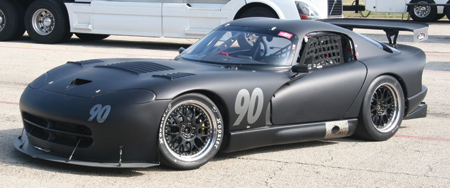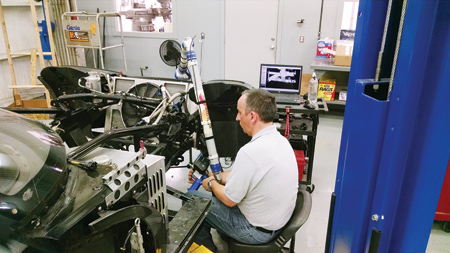
The Dodge Viper that is currently being rebuilt is shown after a race in 2009.

NVision technician scanning the chassis
GSpeed contracted with NVision, Inc. to 3-D scan the chassis of a Dodge Viper as a key step in GSpeed's goal of building what is expected to be among the fastest Vipers in racing history. "NVision, Inc. scanned the chassis at 12 times greater accuracy and with a 27% reduction in cost compared to the manual measurements that had been used in the past," said a spokesperson. The 3-D scanning performed by NVision was a key factor in creating the "Unlimited Class Viper" - one of the most heavily modified second generation Vipers.
"The Dodge Viper has long been a major force in endurance sports car racing, scoring wins in the 24 Hours of Le Mans, 12 Hours of Sebring, Petit Le Mans, 24 Hours of Daytona and the United SportsCar Championship Series among others," said the spokesperson. GSpeed is a racing and racecar mechanic team whose record includes 1st place in the 2011 Dodge Viper Cup Season Finale at Daytona and the 2003 and 2004 SCCA Southwest Division T-1 championships.
One of the key challenges in reengineering the Viper was to determine the actual geometry of the chassis, which had already been modified and then banged up considerably over 15 years of racing.
Knowing the actual geometry of the chassis is critical to designing a new suspension system and other modifications to the current vehicle the team is working on. "If the frame is off by as little as 1/8 of an inch from what we think it is, the performance of the vehicle will drop significantly and all our work will be for nothing," said Jake Sieverling, Design Engineer for GSpeed. In previous projects, the company used hand measurements that were accurate to within about 1/16 inch. "Sieverling estimates that if hand measurements had been used on this project the labor cost would have amounted to about $11,000," said the spokesperson.
"I talked to four service bureaus and picked NVision because they use high-quality equipment that we are familiar with," Sieverling said. "NVision technicians used an NVision HandHeld scanner attached to a mechanical arm that moved about the chassis, capturing data rapidly with a resolution of 0.001 inch. NVision completed the job in less than two weeks and provided a parametric SolidWorks model of the frame as it currently exists.
"Knowing that the geometry we are working with is accurate gives us confidence that we can achieve our goal of building one of the fastest second generation Dodge Vipers ever. We are planning to use this extremely fast vehicle for time trials only at this point rather than as a wheel-to-wheel race car," said Sieverling.
For more information contact:
NVision, Inc.
440 Wrangler Dr.
Suite 200
Coppell, TX 75019
972-393-8000
sales@nvision3d.com
www.nvision3d.com
GSpeed
215 Performance Lane
Cresson, TX 76035
877-512-5180
sales@gspeed.com
www.gspeed.com